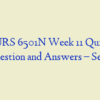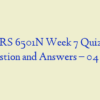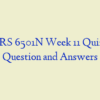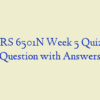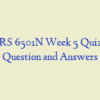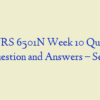Description
NURS 6501N Week 2 Quiz with Answers (40 out of 40)
- A 3-year-old is making play cakes in a sandbox and is eating the play cakes. The sand was also being used by cats as a litter box and was contaminated with toxoplasmosis. Which of the following would most likely also be present?
- An 8-year-old female presents with edema of the cutaneous and mucosal tissue layers. Her mother reports that the condition is recurrent and seems to occur more often during stressful situations. The child is diagnosed with hereditary angioedema. Which of the following is deficient in this child?
- When the maternal immune system becomes sensitized against antigens expressed by the fetus, what type of immune reaction occurs?
- A patient has a tissue growth that was diagnosed as cancer. Which of the following terms best describes this growth?
- Stress induces sympathetic stimulation of the adrenal medulla. This causes the secretion of catecholamines, which include:
- During inflammation, the liver is stimulated to release plasma proteins, collectively known as:
- A 5-month-old child is admitted to the hospital with recurring respiratory infections. A possible cause of this condition is:
- A child fell off the swing and scraped the right knee. The injured area becomes painful. What else will the nurse observe upon assessment?
- Which of the following patients would be at greatest risk for basal cell carcinoma?
- A 30-year-old male is having difficulty breathing and has been spitting blood. He reports that he began experiencing this reaction after cleaning his pigeons’ cages. Testing reveals he is suffering from allergic alveolitis. Which of the following is he experiencing?
- Which of the following individuals would be at greatest risk for an opportunistic infection?
- A 35-year-old male is diagnosed with lobar pneumonia (lung infection). Which of the following exudates would be present in highest concentration at the site of this advanced inflammatory response?
- A 35-year-old male is diagnosed with a hormone-secreting tumor of the adrenal medulla. He experiences elevated blood pressure, pupil dilation, “goose bumps,” and increased anxiety. Which of the following hormones is the predominant one released by the tumor?
- Which patient will develop active immunity? A patient who:
- A 30-year-old female is diagnosed with cancer. Testing reveals that the cancer cells have spread to local lymph nodes. A nurse realizes this cancer would be documented as stage:
- An infant develops a fever secondary to a bacterial infection. Which of the following most likely triggered the fever?
- A 45-year-old male presents with persistent, severe stomach pain. Testing reveals a peptic ulcer. Further laboratory tests reveal the presence of Helicobacter pylori. Which of the following is of concern for this patient?
- After teaching about stress, which information indicates a correct understanding of stress?
- When histamine is released in the body, which of the following responses would the nurse expect?
- Which of the following hormones activates adrenergic receptors? nurs 6501n week 2
- A patient has a disease state that results from the secretion of toxins by bacteria. Which medical diagnosis will the nurse see documented on the chart?
- Exhaustion occurs if stress continues and _____ is not successful.
- When a patient asks the nurse what hypersensitivity is, how should the nurse respond? Hypersensitivity is best defined as:
- A 30-year-old male was diagnosed with HIV. Which of the following treatments would be most effective?
- A patient presents with poison ivy on the extremities, face, and buttocks. This condition is an example of:
- A 34-year-old female was recently diagnosed with RA. Physical examination revealed that inflammation started in the:
- In discoid lupus erythematosus, skin lesions may be accompanied by Raynaud phenomenon, which is manifested by:
- When trying to distinguish between an infectious disease and noninfectious disease, what is the hallmark symptom for most infectious diseases?
- A 76-year-old female was diagnosed with osteoporosis by radiologic exam. She is at high risk for: nurs 6501n week 2
- A 4-month-old female is diagnosed with atopic dermatitis (AD). Which of the following assessment findings by the nurse will most likely support this diagnosis?
- When bacterial pathogens enter a patient’s body, they can defend themselves from an immune response by:
- A 2-month-old female develops diaper dermatitis. A nurse will monitor this patient for which secondary infection that frequently accompanies diaper dermatitis?
- Copy of A 5-year-old female was diagnosed with seropositive juvenile rheumatoid arthritis (RA). The treatment option for this disease is termed:
- A 42-year-old female presents with raised red lesions with a brownish scale. She was diagnosed with discoid lupus erythematosus. A clinician recalls this disorder is related to:
- A 50-year-old male recently underwent a liver transplant and is taking immunosuppressive drugs. He now has painful vesicular eruptions on the face and trunk. He reports that he had chickenpox as a child. Which of the following is the most likely diagnosis based on his chicken pox history?
- When a nurse cares for a patient with systemic lupus erythematosus (SLE), the nurse remembers this disease is an example of:
- The final stage of gout, characterized by crystalline deposits in cartilage, synovial membranes, and soft tissue, is called: nurs 6501n week 2
- A 4-month-old male is brought to his primary care provider for severe itching and skin lesions. He is diagnosed with atopic dermatitis. Which of the following would be elevated in this patient?
- Tinea corporis (ringworm) is a _____ infection of the skin.
- Researchers now believe that RA is:



